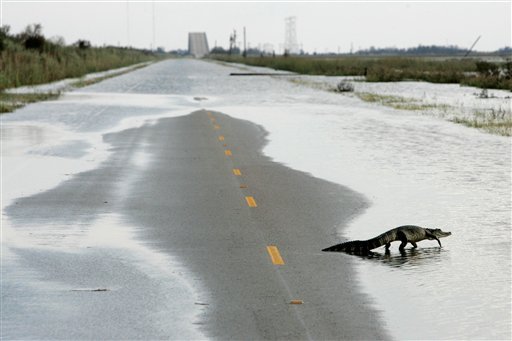The few hundred holdouts on Texas’ ravaged Bolivar Peninsula
will be required to leave in the next few days, and officials said
Tuesday they are ready to use emergency powers to empty the barrier
island scraped clean by Hurricane Ike.
JUAN A. LOZANO – Associated Press
GALVESTON, Texas
The few hundred holdouts on Texas’ ravaged Bolivar Peninsula will be required to leave in the next few days, and officials said Tuesday they are ready to use emergency powers to empty the barrier island scraped clean by Hurricane Ike.
Judge Jim Yarbrough, the top elected official in Galveston County, said the roughly 250 people who defied warnings they would be killed if they rode out the storm in the rural coastal community are a “hardy bunch” and there are some “old timers who aren’t going to want to leave.”
The Texas attorney general’s office is looking into the legal options available to force the remaining residents leave, Yarbrough said. Local authorities are prepared to do whatever it takes to get residents to a safer place.
“I don’t want to do it,” he said. “I’m doing it because it’s in their best interests.”
The sliver of land is just too damaged for residents to stay there, and the population must be cleared so that recovery can begin, officials said. With no gas, no power and no running water, there is also concern about spread of disease.
Entire neighborhoods on Bolivar Peninsula – home to about 30,000 people during the peak of the summer vacation season – were simply wiped away by the height of Ike’s storm surge. In the town of Gilchrist, there are only few buildings still standing. Ferry service to the island is out, as is the bridge on its eastern end. The road that traverses the island is washed out, too.
Yarbrough said officials may never know if people who tried to weather the storm were washed out to sea. So far, there are no confirmed fatalities, but Yarbrough and other officials said he didn’t think that would hold.
“I’m not Pollyana. I think we will find some,” he said.
Yarbrough said leaders would stress to those trying to stay in their damaged homes that they will be allowed to return, and were looking into setting up shelters in Galveston County so these individuals won’t be too far away from their homes. But he said those who live on Bolivar “need to be ready for a marathon, not a race.”
Elsewhere in hard-hit southeast Texas, some residents were being allowed back into emptied communities to dig through their demolished homes – but only briefly.
Across Galveston Bay, Galveston Mayor Lyda Ann Thomas said residents can “look and leave” during daylight hours. Security was tight, and checkpoints would block anyone without a photo id saying they were a Galveston resident from coming in.
Thomas also said the estimated 15,000 people still living on Galveston Island are encouraged to leave, since the city has only limited water and sewer service, and no electricity. The main gas and a primary electric transmission line to the island were severely damaged by Ike, which also tore at the wharves in the city’s port. Officials were worried about mosquito-borne diseases.
“We have a blossoming health and medical concern,” Thomas said. “We are not going to go into somebody’s house and drag them out. But they need to consider the risks of staying here.”
On Galveston’s mostly deserted streets, dogs, cats, and cattle roamed free. Many of the elderly huddled in damaged houses, walking or using bikes when they had to leave because cars were destroyed or damaged. Some pushed salvaged shopping carts down the seawall avenue filled with crates of bottled water and plastic brown pouches holding army MREs obtained from relief centers.
“They’re all over the place,” said Sheila Savage, a Galveston resident who has been bringing food and water to elderly friends who wouldn’t leave because they have no family or other relatives elsewhere. “Their homes were all they have.”
Farther inland in Houston, recovery also was slow. While the city wasn’t as badly hit as the coast, three quarters of the nation’s fourth-largest city was still without power. Authorities pressed Tuesday to deliver relief to survivors, and tens of thousands waited for both food, water and ice. There were still more than 2 million people without power across Texas.
The number of distribution centers in the Houston area was to be quadrupled to 60 by the end of the day. At Texas Southern University, 46-year-old Cinthia Koonce labored as she carried a large box filled with ice and water. Others scrambled for military Meals Ready to Eat and boxes of other foods.
“I have a slipped disc and need to have a knee replacement,” Koonce said. “I’m not supposed to be doing this. But you gotta do what you gotta do.”
President Bush took an aerial tour of the damage Tuesday, then immediately urged Americans to give money to help people recover from Ike. He warned against letting “disaster fatigue” slow donations when the need remains great.
“I have been president long enough to have seen tough situations, and have seen the resilience of the people to be able to deal with the tough situations,” Bush said. “I know with proper help from the federal government and the state government, there will be a better tomorrow.”
Ike’s death toll officially stood at 41 Tuesday, with most of the deaths coming outside of Texas. Among those killed in the state were at least three people who died from carbon monoxide poisoning after using generators.
Associated Press Writers Andre Coe, Chris Duncan, Monica Rhor, April Castro and Deb Riechmann in Houston, Pauline Arrillaga in San Antonio, Allen G. Breed on Bolivar Peninsula, Jay Root in Austin, and Christopher Sherman and Jon Gambrell in Galveston, contributed to this report.













